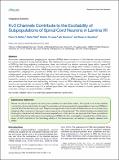Files in this item
Kv3 channels contribute to the excitability of subpopulations of spinal cord neurons in Lamina VII
Item metadata
| dc.contributor.author | Mullen, Pierce | |
| dc.contributor.author | Pilati, Nadia | |
| dc.contributor.author | Large, Charles H | |
| dc.contributor.author | Deuchars, Jim | |
| dc.contributor.author | Deuchars, Susan | |
| dc.date.accessioned | 2022-02-23T16:30:06Z | |
| dc.date.available | 2022-02-23T16:30:06Z | |
| dc.date.issued | 2022-01-20 | |
| dc.identifier | 277738115 | |
| dc.identifier | de99a4a6-afdf-4475-995a-cb17a8956982 | |
| dc.identifier | 35058310 | |
| dc.identifier | 85124914150 | |
| dc.identifier.citation | Mullen , P , Pilati , N , Large , C H , Deuchars , J & Deuchars , S 2022 , ' Kv3 channels contribute to the excitability of subpopulations of spinal cord neurons in Lamina VII ' , eNeuro , vol. 9 , no. 1 . https://doi.org/10.1523/ENEURO.0510-21.2021 | en |
| dc.identifier.issn | 2373-2822 | |
| dc.identifier.other | Jisc: ae83bc44af9c4ff4b9fe99691293abee | |
| dc.identifier.other | pii: ENEURO.0510-21.2021 | |
| dc.identifier.other | ORCID: /0000-0003-0640-4041/work/108919661 | |
| dc.identifier.uri | https://hdl.handle.net/10023/24946 | |
| dc.description | This work was supported by BBSRC grant BB/L01565X/1. | en |
| dc.description.abstract | Autonomic parasympathetic preganglionic neurons (PGN) drive contraction of the bladder during micturition but remain quiescent during bladder filling. This quiescence is postulated to be due to recurrent inhibition of PGN by fast-firing adjoining interneurons. Here, we defined four distinct neuronal types within lamina VII of the lumbosacral spinal cord, where PGN are situated, by combining whole cell patch clamp recordings with k-means clustering of a range of electrophysiological parameters. Additional morphological analysis separated these neuronal classes into parasympathetic preganglionic populations (PGN) and a fast firing interneuronal population. Kv3 channels are voltage-gated potassium channels (Kv) that allow fast and precise firing of neurons. We found that blockade of Kv3 channels by tetraethylammonium (TEA) reduced neuronal firing frequency and isolated high-voltage-activated Kv currents in the fast-firing population but had no effect in PGN populations. Furthermore, Kv3 blockade potentiated the local and descending inhibitory inputs to PGN indicating that Kv3-expressing inhibitory neurons are synaptically connected to PGN. Taken together, our data reveal that Kv3 channels are crucial for fast and regulated neuronal output of a defined population that may be involved in intrinsic spinal bladder circuits that underpin recurrent inhibition of PGN. Neural circuits in the spinal cord and pons mediate the micturition reflex. The spinal cord drives bladder contraction during micturition through the activation of parasympathetic preganglionic neurons in lamina VII of the lumbosacral spinal cord. Despite the significant contribution of these neurons to a crucial physiological reflex, neurons in this region have been under-characterised. This study therefore elucidated and thoroughly characterised distinct neuronal populations in this lamina; we propose that these populations included a fast firing interneuron and subtypes of parasympathetic preganglionic neurons. Further investigation revealed the critical importance of Kv3 channels in the fast firing ability of the interneurons, as well as in synaptic release onto PGNs. | |
| dc.format.extent | 16 | |
| dc.format.extent | 4802575 | |
| dc.language.iso | eng | |
| dc.relation.ispartof | eNeuro | en |
| dc.subject | Bladder reflex | en |
| dc.subject | Spinal cord | en |
| dc.subject | Kv3 channels | en |
| dc.subject | Parasympathetic | en |
| dc.subject | RC0321 Neuroscience. Biological psychiatry. Neuropsychiatry | en |
| dc.subject | NDAS | en |
| dc.subject | MCC | en |
| dc.subject.lcc | RC0321 | en |
| dc.title | Kv3 channels contribute to the excitability of subpopulations of spinal cord neurons in Lamina VII | en |
| dc.type | Journal article | en |
| dc.contributor.institution | University of St Andrews. School of Psychology and Neuroscience | en |
| dc.identifier.doi | 10.1523/ENEURO.0510-21.2021 | |
| dc.description.status | Peer reviewed | en |
This item appears in the following Collection(s)
Items in the St Andrews Research Repository are protected by copyright, with all rights reserved, unless otherwise indicated.

